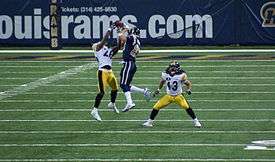Defensive back

In American football and Canadian football, defensive backs (DBs) are the players on the defensive team who take positions somewhat back from the line of scrimmage; they are distinguished from the defensive line players and linebackers, who take positions directly behind or close to the line of scrimmage.[1] The defensive backs, in turn, generally are classified into several different specialized positions:
- Safety:
- Free safety – most often the deepest safety
- Strong safety – the bigger more physical safety, much like a small, quicker linebacker
- Defensive halfback (Canadian football only)
- Cornerback – which include:
- Nickelback – the fifth defensive back in some sets, such as the nickel formation
- Dimeback – the sixth defensive back in some sets, such as the Dime formation
- The seventh defensive back, in the exceedingly rare 'quarter' set, but often strong
- known as a dollar back or a quarter back (not to be confused with the offensive player who throws the ball)
The group of defensive backs is known collectively as the secondary.[2] They most often defend the wide receiver corps; however, at times they may also line up against a tight end or a split out running back.
References
See also
| Positions in American football and Canadian football | |||||||
|---|---|---|---|---|---|---|---|
| Offense | Defense | Special teams | |||||
| Linemen | Guard, Tackle, Center | Linemen | Tackle, End | Kicking players | Placekicker, Punter, Kickoff specialist | ||
| Quarterback | Linebackers | Snapping | Long snapper, Holder | ||||
| Backs | Halfback (Tailback), Fullback, H-back | Backs | Cornerback, Safety, Halfback | Returning | Punt returner, Kick returner, Jammer | ||
| Receivers | Wide receiver, Tight end, Slotback | Nickelback, Dimeback | Tackling | Gunner, Upback | |||
| Formations (List) — Nomenclature — Strategy | |||||||
This article is issued from Wikipedia - version of the 11/25/2016. The text is available under the Creative Commons Attribution/Share Alike but additional terms may apply for the media files.